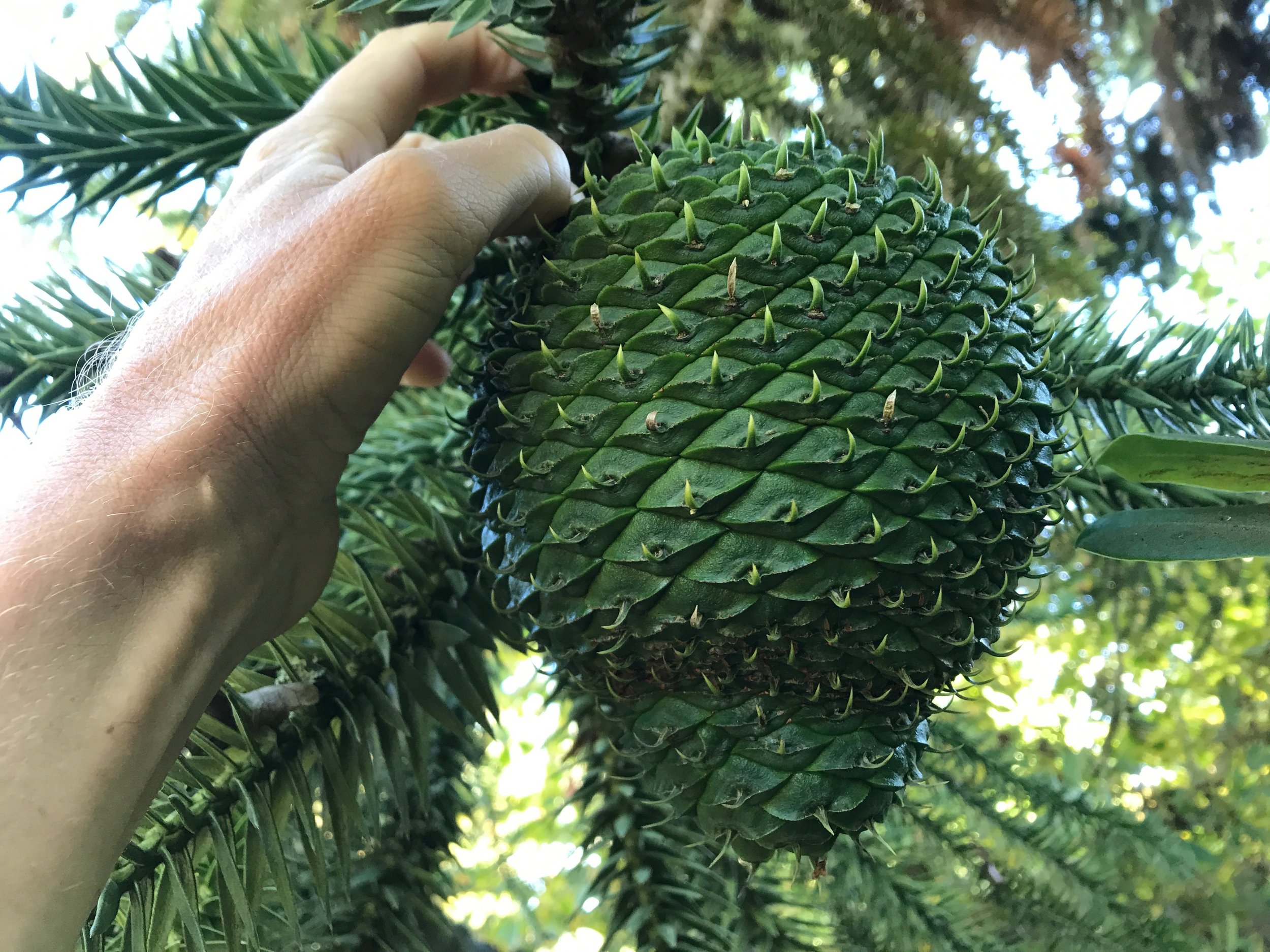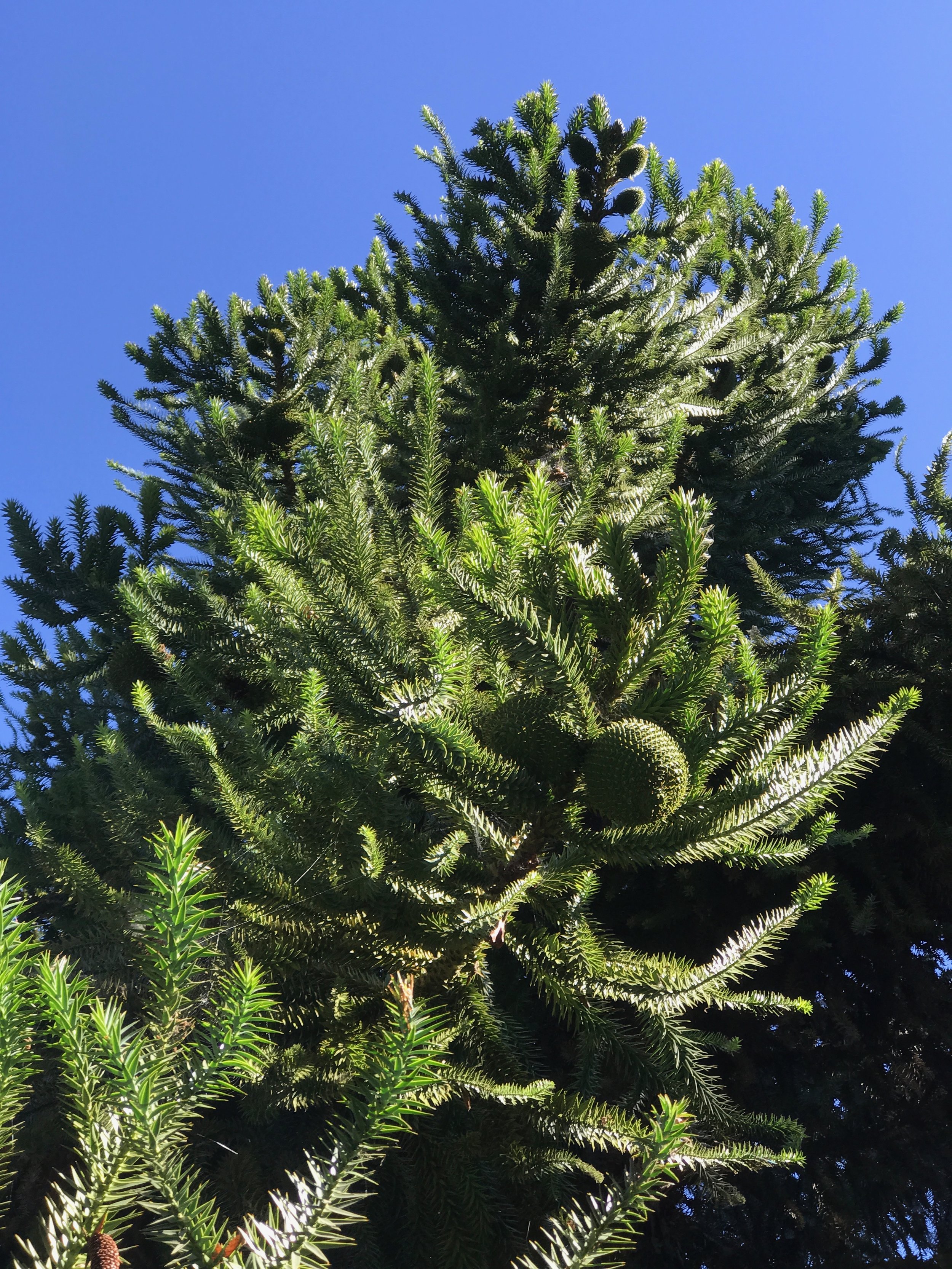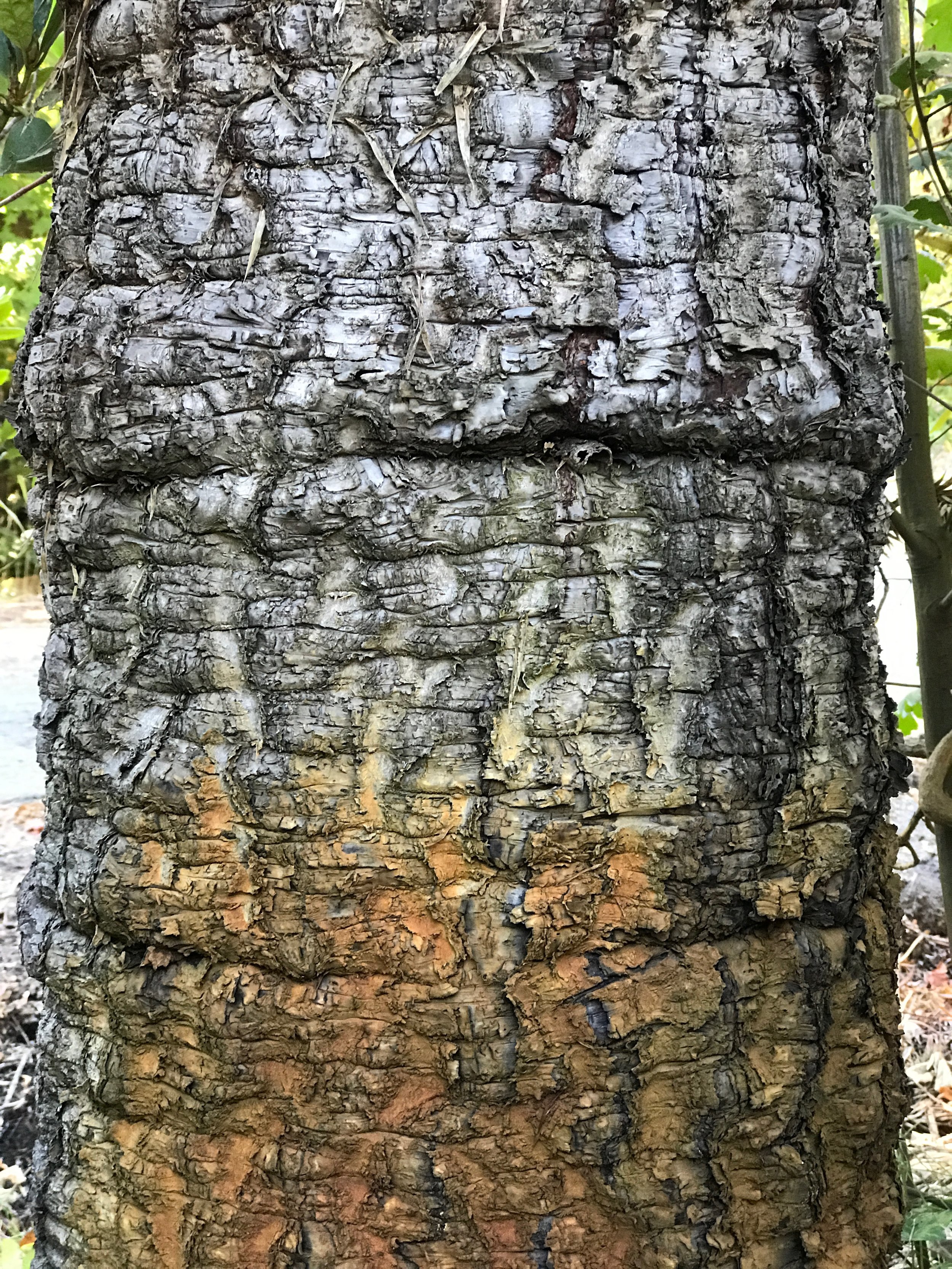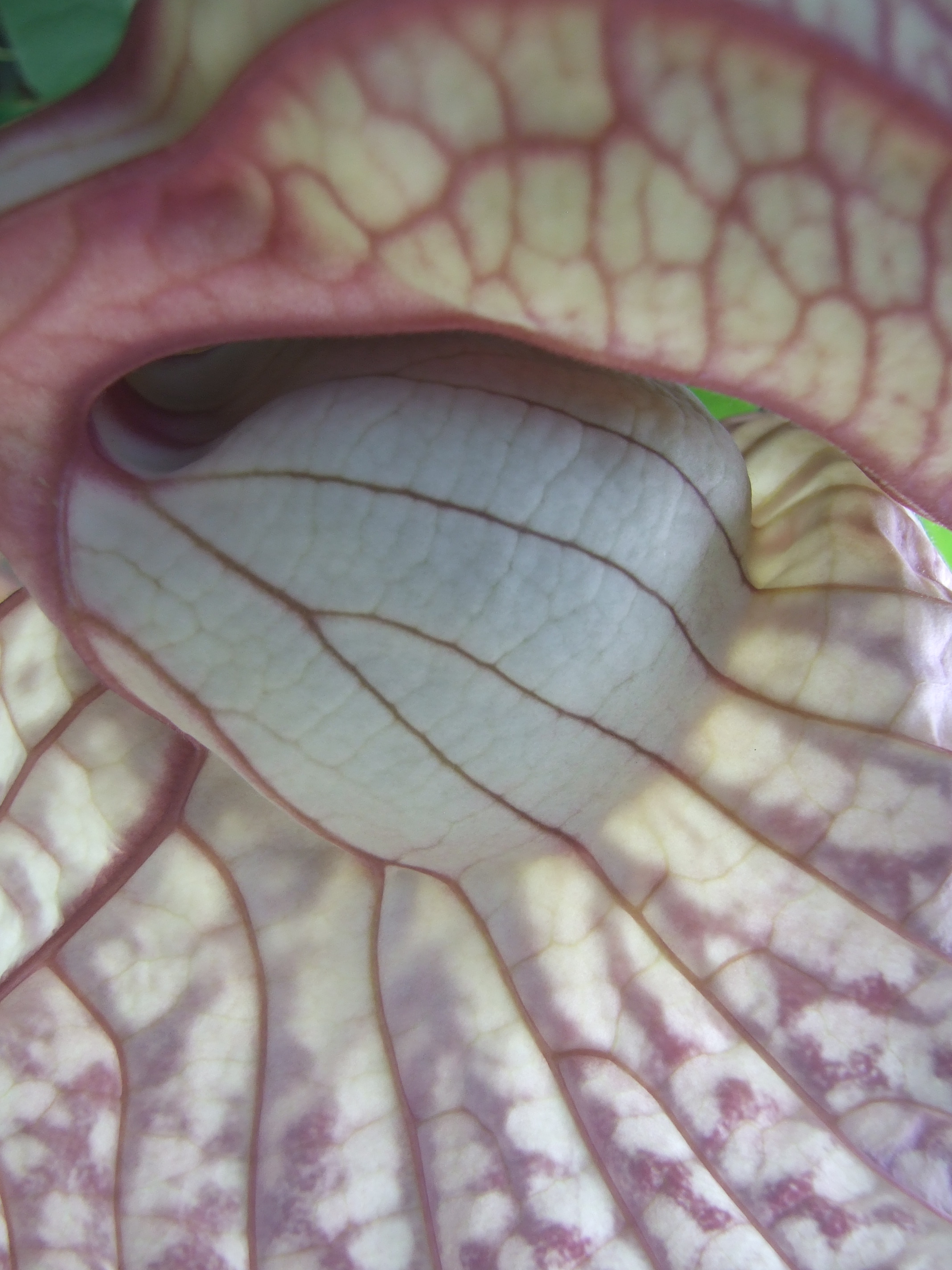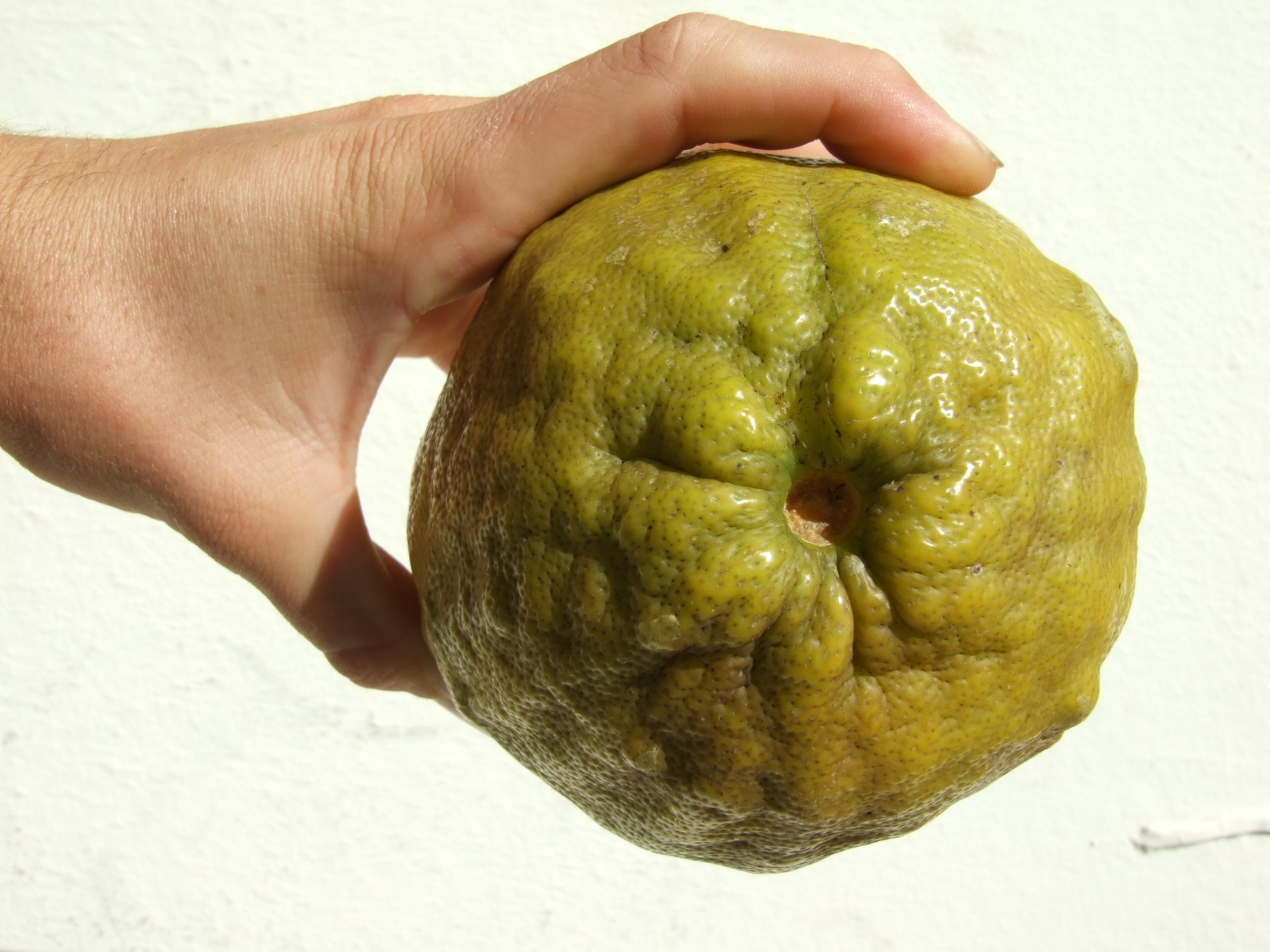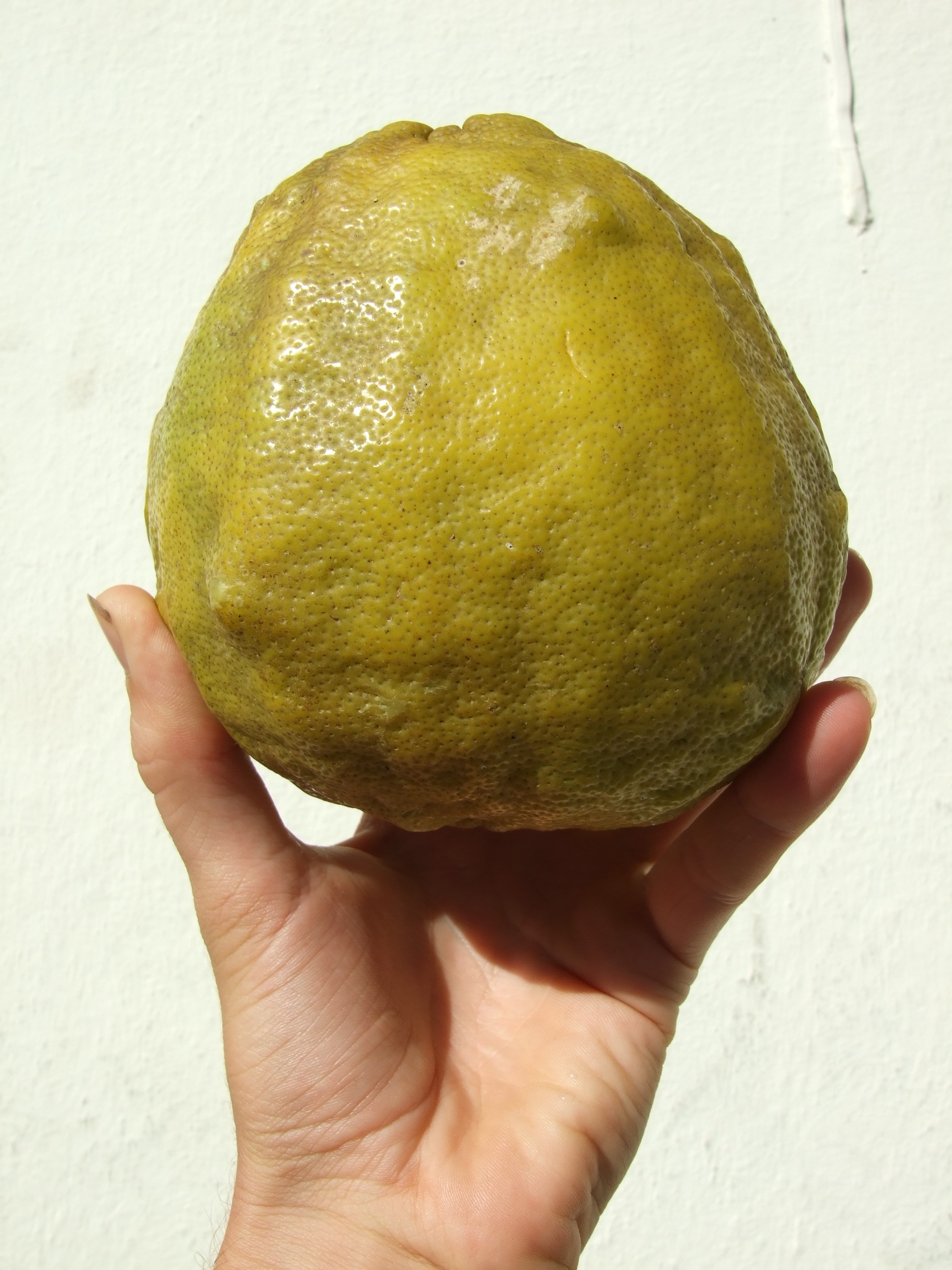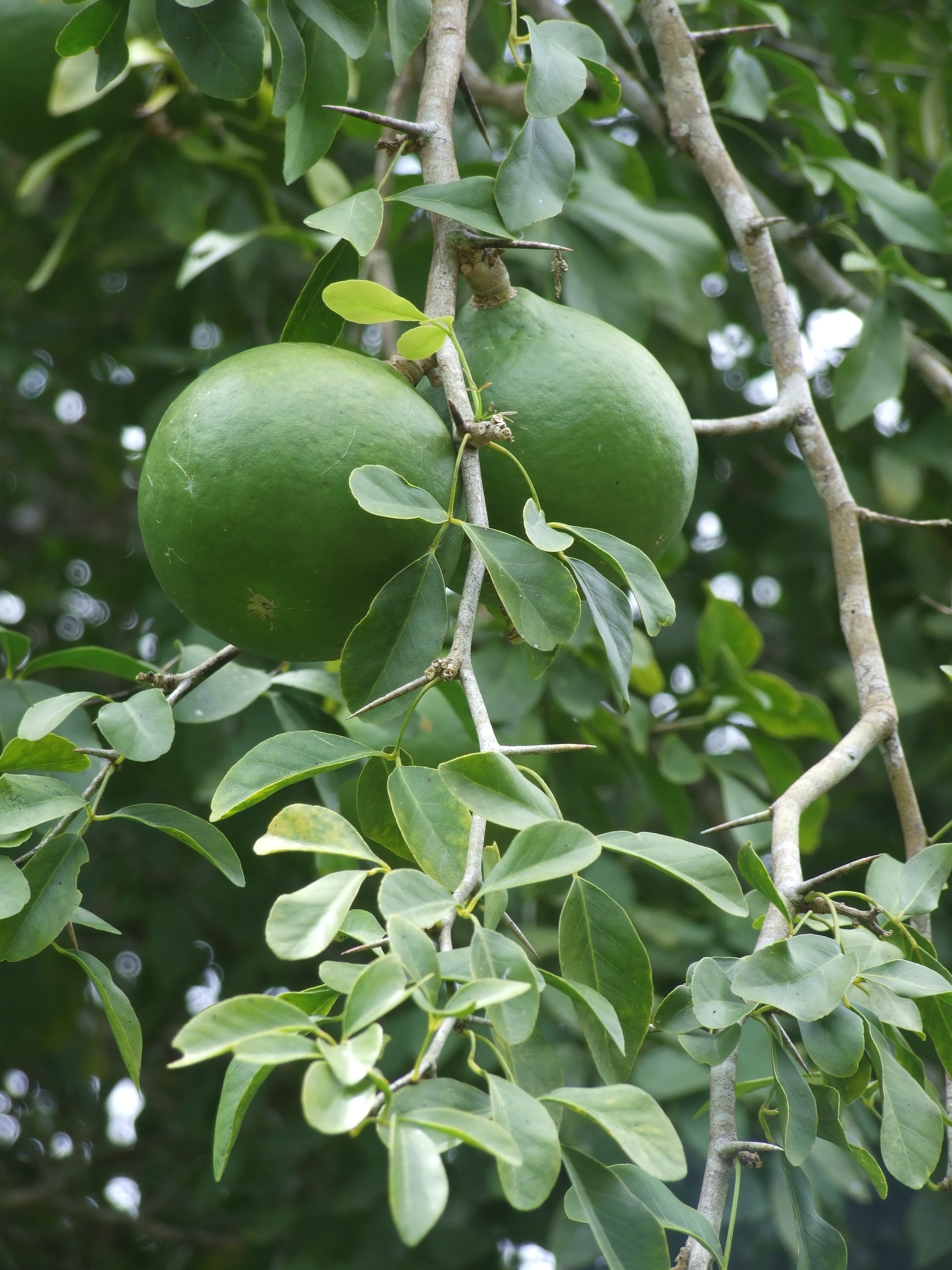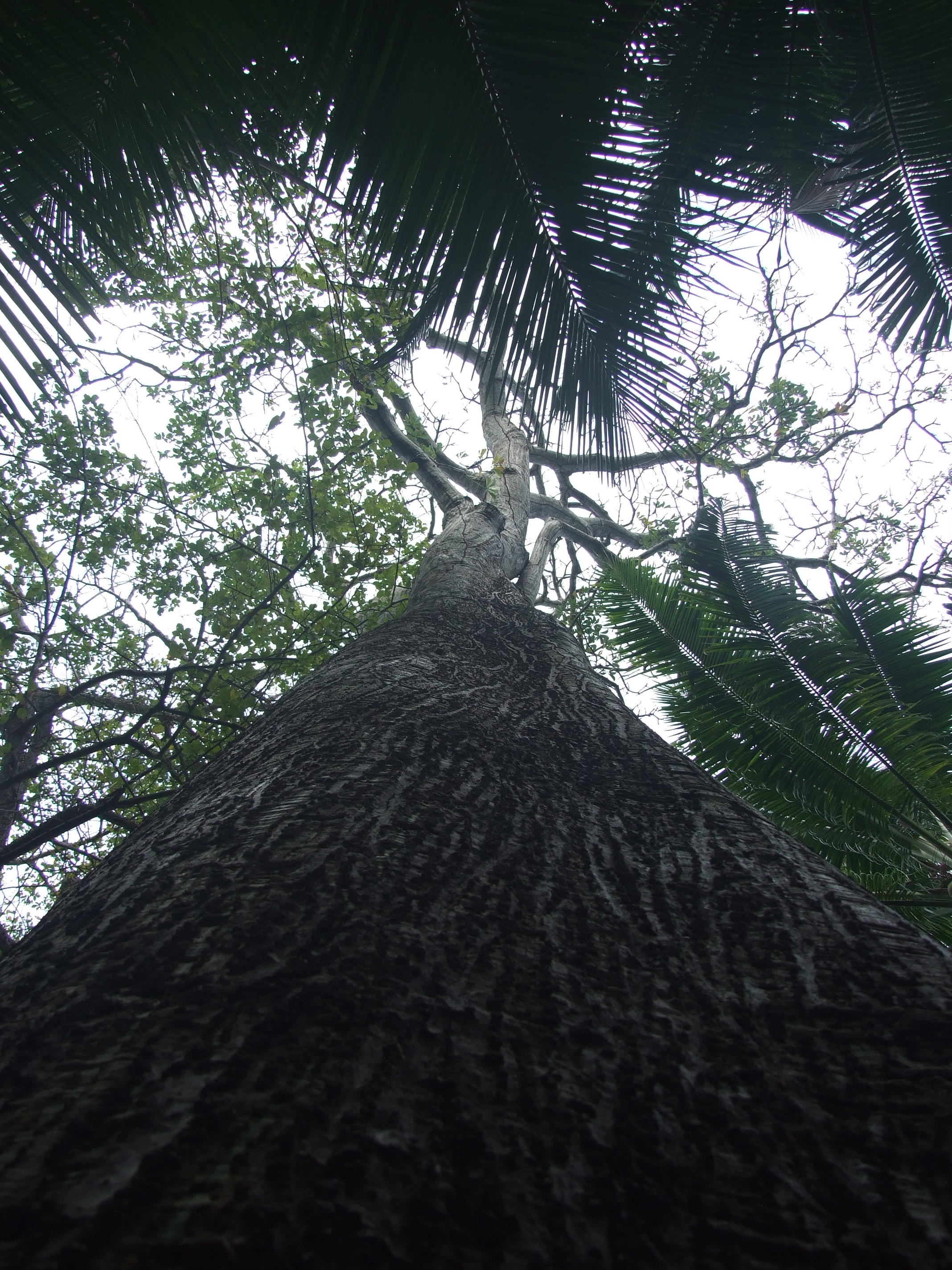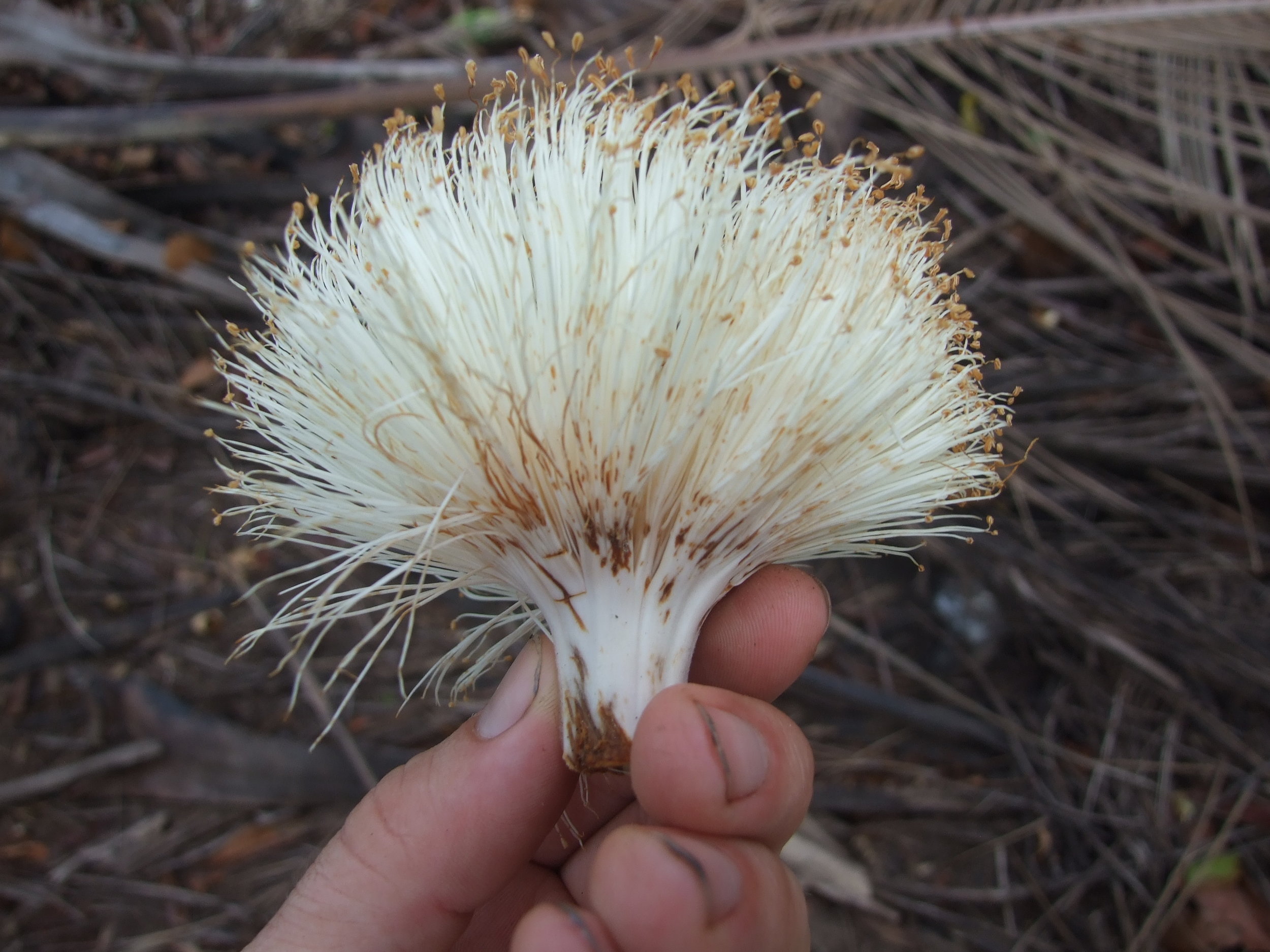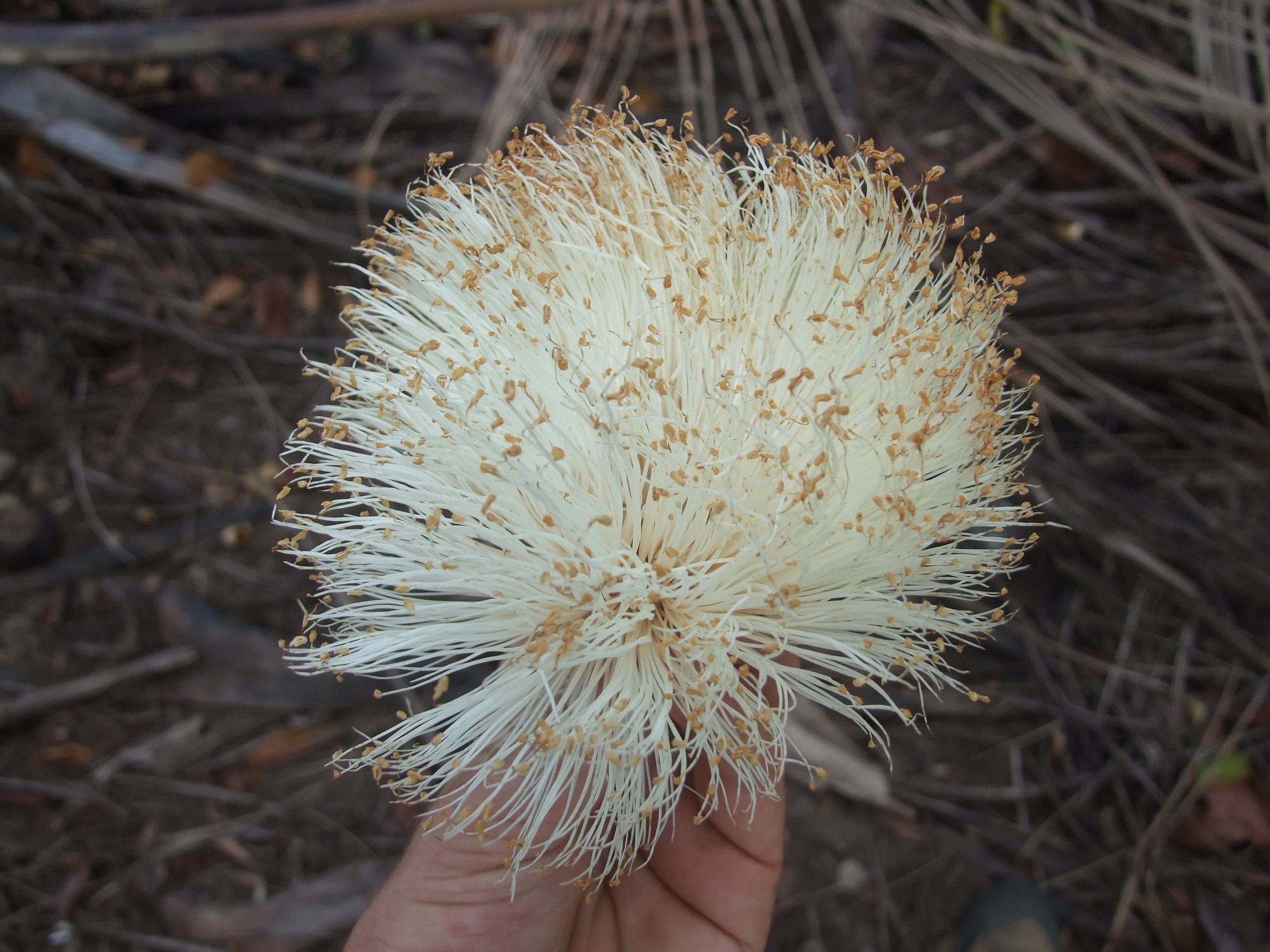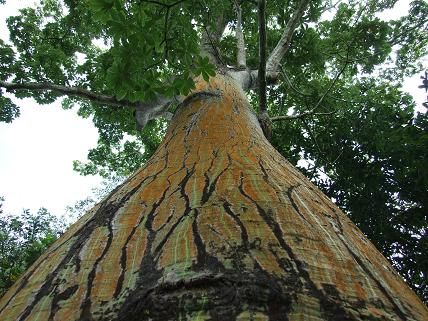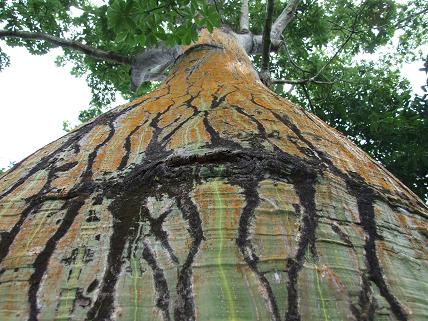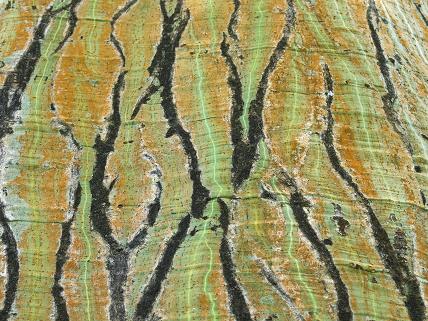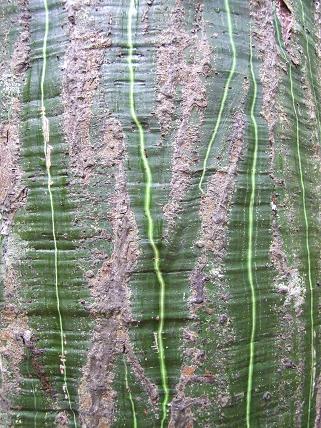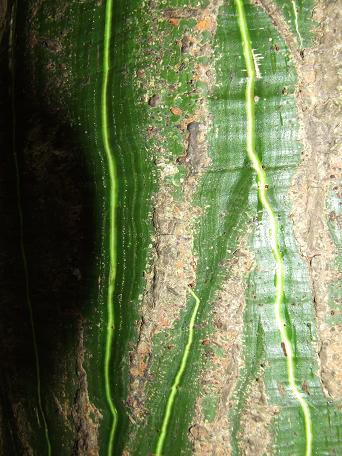Canarium commune - Canari, Java Almond, Kenari Nut
I'm pretty sure this is Canarium commune (photos below), a close relative of Canarium ovatum, the Pili Nut. I took this photo and collected seed from Summit Botanic Garden outside of Panama City in Central America where they also have a collection of Pili nut among many other interesting species from their earlier years as an experimental garden.
Canarium commune, also known as Java Almond or Kenari Nut, is a tree native to Southeast Asia from Indonesia to New Guinea.
USES and ETHNOBOTANY
The edible nut / kernal can be eaten raw or cooked and is prepared in a variety of ways. In its area of origin it is highly valued as a traditional snack. The nuts can be used as a substitute for the common almond.
Nuts can be ground into a powder and used to make bread. The seeds are used in a wide variety of dishes by the local people. The seed contains about 72% oil, 13% protein and 7% starch. Interestingly, it has been found that adding a strained emulsion of the crushed, ripe kernels to cows milk will make the milk much more digestible when fed to babies and infants. An edible oil is obtained from the seed which is preferred to coconut oil by local people where Java Almond is traditionally grown and consumed.
An oil derived from Canarium commune is also used in the cosmetic and aeromatics industries called Elemi Oil. Elemi produces a bright lemony, woody fragrance with a hint of fennel, frankincense and grass. Elemi is known to be clarifying and cleansing with energizing properties. It stimulates mental ability and works well for morning meditation, tai chi or yoga exercises. It creates a spirit of hopefulness and is said to relieve depression.
Traditionally, people use elemi with substances that are refreshing and cleansing such as mastic, lemongrass, and sweet grass.
Elemi is also used topically to treat skin disorders and ulcers.
AGROFORESTRY
In agroforestry systems the tree is traditionally planted in nutmeg groves to provide shelter and shade and a secondary overstory crop.
The tree and its various products have a wide range of additional traditional uses.
Aristolochia grandiflora
Aristolochia grandiflora detail.
Nephelium lappaceum - Rambutan, Mamon Chino
Native to Malaysia and Indonesia, the Rambutan is one of the most popular and common fruits in Southeast Asia where it is grown both on a domestic level, as a patio tree, and at a commercial level. It has been introduced to some areas of Africa and Central America, like Costa Rica and Panama, to a lesser extent. The Rambutan is a medium size tree reaching 15 -25 meters in height, with a straight trunk and a dense canopy.
The fruit is the shape of an egg encapsulated in a red, yellow, or sometimes orange casing covered in soft spiny hairs. The sweet, juicy, aromatic fruit is translucent and surrounds a large seed. There exist freestone cultivars. Fruit can range in acidity, yellow varieties tending to be more acidic than red.
Reportedly the seed is edible. I forget where I first heard this, but I have eaten the seeds raw, which are not disagreeable in flavor and gave me the sense that they were especially nutritious. Any further info regarding Rambutan seed edibility would be greatly appreciated.
The Rambutan fruit, like the Lychee, is rich in sugar (11%) and vitamin C.
There are more than 100 varieties of Rambutan in Indonesia, Malaysia and Thailand. Culitvars are distinguished by whether they are best consumed fresh (Ayer Mas, Chooi, Ang, Kelip, Rongrien, Tau po Cheng), or used in preserves (Chompu, Kepala Besar).
The Rambutan is a tree from the humid tropics. It isn't found cultivated higher than 600 meters. It has not been successfully cultivated in Florida and other subtropical areas and does not tolerate long periods of drought. The tree is not especially selective in soil type although it does best in heavy clay soils with a heavy organic mulch layer.
Nephellium mutabile - Pulasan
The Pulisan is native to South East Asia, widely cultivated in Indonesia, especially on the island of Java. It is also relatively well known in Malaysia, Thailand, and the Philippines. The tree grows up to 10 - 15 meters, with spreading branches and an irregular crown. The fruit is 5-8 cm long and 3-5 cm wide encased in a red or yellow capsule covered in short, soft spines, similar to that of the Rambutan, a close relative to the Pulasan. The fruit is most similar to the Rambutan, typically consumed raw, also made into marmalades and preserves.
There are two known groups of Pulasan varieties. Dark red and yellow. There are freestone cultivars in both groups. The most prized varieties are "Silbabat" and "Koneng".
The Pulasan requires a hot, humid climate. Trees cannot withstand prolonged dry seasons. To obtain quality fruit the tree needs deep, well drained soil, rich in organic matter.
The tree is propagated by seed, graft and air layer.
Citrus, spp., Unidentified giant lemon variety
This is a large Citrus species. The fruit were given to me years ago when I lived in Panama City's Old Quarter. Almost everyday I would visit a fruit vendor in Santa Ana to buy a small watermelon and a pineapple. He knew I worked with plants and collected fruit species so occasionally we would exchange fruit. I would bring miracle fruit, jaboticaba, jackfruit, curry tree fruit, and others, none of which he had ever seen. Him and his family would bring me highly regarded or lesser known fruit varieties from the interior of the country, giant Nance, Algarrobo (Hymenia coubaril), Mangos.
I never verified the species of this particular Citrus, it looks like some kind of Pomelo / Citron hybrid and has a relatively think skin compared to the size of the fruit.
Any thoughts on the species?
Aegle marmelos - Bael fruit, matoom, Indian quince, golden apple, holy fruit, stone apple, elephant apple
BACKGROUND, ORIGIN, AND DISTRIBUTION
Syn. Feronia pellucida, Crataeva marmelos) Bael fruit is a citrus relative. One can see the similarity in the leaves and growth habit of the tree. Bael fruit is native to the dry forests, in the hills and plains of Burma, Pakistan and Bangladesh. The species can be found cultivated throughout India, where, due to its status as a sacred tree is grown in Buddhist temples where monks slice and dry fruit, then heat it in water to make a popular hot drink. The tree can be found cultivated in Southeast Asia, Indo-China, Thailand and N. Malaysia.
Bael grows up to 15 m in height. The bark is smooth and light gray in color, leaves are relatively small, deciduous, alternate, ovate - lanceolate, trifoliate. Branches are spiny. Like many of the Rutaceae family, Bael has fragrant flowers.
The fruit matures at between five and twenty centimeters. The ones I've seen are typically the size of a softball and has hard brittle shell, not dissimilar to that of the calabash tree. The inside is full of a very sticky, fibrous pulp around many seeds, which look like large grapefruit seeds. The outside is a hard, brittle shell, slightly thicker then that of the calabash tree. When ripe, the fruit emits an extremely pleasant aroma and can sit around for weeks doing so. Superior cultivars can yield over 400 fruit a year. Better varieties tend to have thinner rinds. The tree I have collected seed from seems to produce a lot, but the rinds are fairly thick, the fruit basically has to be stomped on, thrown onto a hard surface, or hit with a hammer to be broken open.
USES AND ETHNOBOTANY
The leaves of Bael fruit are considered sacred in the Hindu culture, offered as sacrament to Lord Shiva, thus it is highly prohibited to uproot the trees. Shiva is believed to live underneath the tree.
The fruit is also made into jams and preserves. Young leaves and shoots are used to season food in Indonesia and eaten as a vegetable in Thailand.
Above all else Bael fruit seems to have potential for its medicinal benefits. In Asia it is widely used for such purposes. The fruit, roots and leaves all have antibiotic qualities. Unripe fruit are eaten by those recovering from dysentery. In India it is a highly revered as an aphrodisiac. Large quantities of the fruit are considered to act as a depressant, slowing the heart rate and inducing sleepiness. Juice extracted from the leaves is given to relieve the symptoms of asthma and fever. Tea made from the flowers is used to cleanse eye infections. Tea made from the root are used to relieve heart palpitations, indigestion, bowel inflammations and to stop vomiting and relieve nausea.
Interestingly, the fruit pulp, in addition to its edible and medicinal properties, is also used as glue; mixed with lime and plaster and employed as a sealant; mixed with cement and used when building walls; and added to watercolor paints. In the cosmetic industry the limonene-rich oil is used to scent hair products. The rind yields a yellow dye.
PROPAGATION AND CULTIVATION
Trees can grow in a wide variety of soils in full sun or partial shade. It is considered sub-trpopical but I grow it in Panama, the full=on tropics.
Again, I am not familiar with a wide range of varieties, the one I have eaten has many seeds surrounded by a thick, stick pulp. The pulp is somewhat similar in consistency to other citrus, and is divided into sections. The pulp is very aromatic. As is done traditionally in Asia, I have consumed it in a drink, basically made a tea out of the pulp.
Pseudobombax septenatum - Ceibo Barrigon, Barrigon
Pseudobombax septenatum is a large tree with a tall straight trunk that is usually swollen at the base. The bark has bright vertical lines, especially apparent in juvenile trees as is apparent in the images below.
P. septenatum is a highly deciduous species, dropping all of its leaves around December and leafing out again with the rains in April and May. The trunk stores water during the dry season and the tree uses these stores to fill out flowers and fruit.
I took these photos on the island Pedro Gonzalez off the Pacific coast of Panama. This species species appears to be one of the tallest canopy trees on the island.
Theobroma cacao- Chocolate, Cacao
BACKGROUND, ORIGIN AND DISTRIBUTION
There's a lot that can be said about this species.
Theobroma cacao ripe pods.
Some of the latin synonyms are: Cacao guianensis Aubl., Cacao minus Gaertn., Cacao sativa Aubl., Theobroma caribaea Sweet, Theobroma interregima Stokes, Theoboma kalagua De Wild, T. leiocarpa Bernoulli, T. pentagona Bernoulli.
Some of the folk names include: Ah kakaw (Lacandon), aka-'i (Ka'apor), aka-'iwa (Ka'apor), bana torampi (Shipibo), biziaa (Zapotec), bizoya, cacahoaquiahuit, cacahoatl, cacahua, cacahuatl, cacao, cacaocuahuitl (Aztec).
The list of folk names goes on and on. Cacao has been a significant species for melenia. The tree was cultivated throughout areas of Central America 4,000 years ago where it was venerated as a divine substance, a food of the gods, and was primarily consumed during rituals and offered to the gods. Thus the plant genus is called Theobroma, meaning "gods" "food" in Latin. Cacao is a word borrowed from the Mayan language and refers to the tree, the fruit, and the drink that is prepared from the fruit. The word chocolate is derived from the Aztec word xocolatl.
USES AND ETHNOBOTANY
Cacao beans were held in extremely high regard by the Aztecs who used them as food, stimulant, medicine and currency. Notably, as a currency, the cacao bean was typically used as standard fare to pay prostitutes. Perhaps this has something do to with the beans aphrodesiac properties.
The Aztec viewed the cacao tree as a gift form the god Quetzalcoatl. The following, extracted from an Aztec text, provides a precise description of the tree and of the drink:
Cacaoaquavitl - Cacao Tree
It has broad branches. It is simply a round tree. Its fruit is like the ears of dried maize, like an ear of green maize, some whitish brown. Its name is "cacao ear." Some are reddish brown, some whitish brown, some bluish brown. Its heart, that which is inside it, its filled insides, is like an ear of maize. The name of this when it grows is cacao. This is edible, is drinkable. This cacao, when much is drunk, when one consumes much of it, especially that which is green, which is tender, makes one drunk, has an effect upon one, makes on ill, makes one confused. If a normal amount is drunk, it makes one happy, refreshes one, comforts one, strengthens one. Thus it is said: "I take cacao, I moisten my lips. I refresh myself." (Sahagun, 11)
Initially, when cacao beans were first brought to Europe by Hernan Cortez it was used almost exclusively in the production of love drinks
Today, although the wild form of the plant (T. lacandonense) is found only in the jungles of southern Mexico, domesticated cacao can be found grown as a crop throughout many of the tropical rainforest regions of the world, throughout the Americas, in southeast Asia, and parts of Africa.
I have found wild cacao relative, Herrania purpurea, on an island off the Caribbean coast of Panama. The pod is smaller than T. cacao. When opened the pod contains a similar white pulp surrounding smaller seeds.
Interestingly, in ancient Nicaragua, cacao farmers were required to abstain from sex for thirteen days prior to planting cacao seeds so they would not make the chocolate god (moon god) angry.
Generally speaking, cacao served (and still serves) the important function as a vehicle for administering other psychoactive plants and fungi (Ott 1985). The Aztecs ingested cacao together with entheogenic mushrooms (Psilocybe spp.) Associated rituals are still practiced amongst numerous tribes today.
In ancient America, cacao was esteemed as a tonic and aphrodisiac. Cacao is also used in indian fold medicine to treat diarrhea and scorpion stings. Kuna women (Panama) drink a decoction of the fruit pulp as a pregnancy tonic. Fresh young leaves are applied externally as an antiseptic agent. In Peru, cacao is drunk primarily as a diuretic and in cases of kidney infection.
Cacao beans contain 18% protein, 56% lipids, 13.5% carbohydrates, 1.45% theobromine, .05% caffeine, and 5% tannin.
The following cacao recipe was said to have been brought by conquistador Hernan Cortez to Spain in 1528:
700 g cacao
750 g sugar
56 g cinnamon (probably Canella winterana)
14 Mexican peppercorns (Capsicum spp.)
14 g spice cloves (Pimenta dioica)
3 vanilla pods
1 handful of anise (probably Tagetes lucida)
1 hazelnut
musk, grey amber, and orange blossom water
Edible Condiment Leaves of Southeast Asia
The following is a list of species whose leaves are used as condiments in Southeast Asia. The list is not, by any means, complete, but includes some of the lesser known, more obscure species.
Acacia farnesiana, Cassie flower, Leguminaceae
Achronychia laurifolia, Ketiak, Rutaceae
Aegle marmelos, Bael fruit, Rutaceae
Allium odorum, Chinese chives, Liliaceae
Ancistrocladus extensus, Ox-tongue, Dipterocarpaceae
Antidesma ghaesembilla, Sekinchak, Euphorbiaceae
Begonia tuberosa, Tuberous begonia, Begoniaceae
Claoxylon polot, Rock blumea, Euphorbiaceae
Coleus tuberosus, African potato, Labiatae
Crypteronia paniculata, Sempoh, Lythraceae
Curcuma domestica, Turmeric, Zingiberaceae
Cymbopogon citratus, Lemon Grass, Graminae
Cyrtandra decurrens, Graminae
C. pendula, Rock sorrel, Graminae
Dendrobium salaccense, Cooking orchid, Orchidaceae
Derris heptaphylla, Seven finger, Leguminaceae
Elethariopsis sumatrana, Frangrant gingerwort, Zingiberaceae
Eugenia polyantha, White kelat, Myrtaceae
Evodia roxburghiana, Sour-relish wood, Rutaceae
Gymura procumbens, Akar, Compositae
Homalomena graffithii, Itch grass, Araceae
Hornstedtia, Tepus, Zingiberaceae
Horsfieldia sylvestris, Pendarahan, Myristicaceae
Kaempferia galanga, Chekur (Galangal), Zingiberaceae
Kaempferia rotunda, Kenchur, Zingiberaceae
Leucas lavandulifoia, Ketumbak, Labiatae
L. zeylanica, Ketumbak, Labaiatae
Limnophila aromatica, Swamp leaf, Scrophulariaceae
L. villosa
L. conferta
L. pulcherrima
L. rugosa
Lycium chinese, Kichi, Matrimony vine, Solanaceae
Lycopersicum esculentum, Tomato, Solanaceae
Medinilla crispata, Medinilla, Melastomataceae
M. hasseltii
M. radicans
Mentha longifolia, Longleaf mint, Labiatae
Murraya koenigii, Curry-leaf tree, Rutaceae
Nauclea esculenta, Pincushion, Rubiaceae
Ocimum canum, Hoary basil, Labiatae
Oenanthe javanica, Shelum, Umbelliferae
Ottelia alismoides, Pojnd lettuce, Hydrocharitaceae
Oxalis corniculata, Sorrel, Oxalidaceae
Pilea melastomoides, Sweet nettle, Urticaceae
Piper lolot, Pepper leaf, Piperaceae
P. caducibracteum
P. umbellatum
Pistacia lentiscus, Pistachio resin tree, Anacardiaceae
Pluchea indica, Indian sage, Comppositae
Polygonum hydropiper, Water polygonum, Polygonaceae
Staurogyne elongata, Cross flower, Acanthaceae
Trachyspermum involucratum, Wild celery, Umbelliferae
